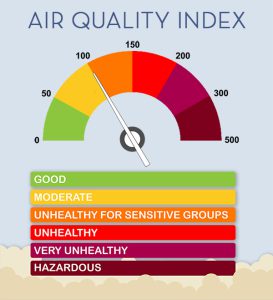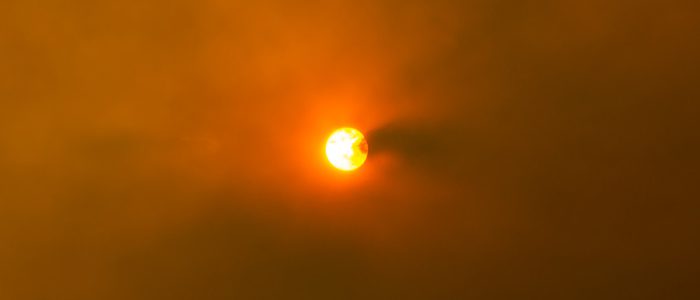JULY 2023
 Lately, there has been much attention on the air quality in the Upper Midwest and nationwide. Wildfire smoke, which contains a mixture of air pollutants, has been causing frequent air quality alerts.
Lately, there has been much attention on the air quality in the Upper Midwest and nationwide. Wildfire smoke, which contains a mixture of air pollutants, has been causing frequent air quality alerts.
Air quality has a big impact on health. When breathing in wildfire smoke and other pollutants, some people may experience short-term physical effects like difficulty breathing, coughing, and fatigue. Over time, air pollution can worsen existing health conditions and make respiratory infections, heart disease, stroke, and lung cancer more likely.
Wildfire smoke and poor air quality affect farmers and farm workers.

Since agriculture is an outdoor job, it’s important to be in the know about air quality, the dangers of working outside, and how to stay safe. UMASH has compiled a toolkit with many resources to help farmers know the key terms, hazards, and strategies to keep themselves safe and healthy in these dangerous environmental conditions.
VIEW RESOURCES:
- What Agricultural Producers Need to Know About Wildfire Smoke
High Plains Intermountain Center for Agricultural Health and Safety (HICAHS)
This two-minute video helps agricultural producers identify how wildfire smoke can impact their health, how to avoid and reduce exposure to wildfire smoke, and how to protect other people working on the farm, ranch, or dairy.
- Outdoor Workers Exposed to Wildfire Smoke
CDC/National Institute for Occupational Safety and Health (NIOSH)
This page provides information and resources about wildfire smoke, its impact on health, and actions to consider to reduce exposure to smoke.
- Wildfire Smoke Exposure
Western Center for Agricultural Health and Safety (WCAHS)
This webpage provides resources, available in both English and Spanish, for wildfire smoke safety training and posters on respirators and smoke exposure in the workplace.
- Wildfire Smoke Safety
Pacific Northwest Agricultural Safety and Health Center (PNASH)
This page provides resources for wildfire smoke safety, including employer checklists in English and Spanish.
- Protecting Workers and the Public from Wildfire Smoke
CDC/National Institute for Occupational Safety and Health (NIOSH)
This page provides guidance for protecting workers and the public from wildfire smoke, with information about respirators and more.
- Well, it’s Wildfire Season
Your Local Epidemiologist
This article provides simple, epidemiological information about wildfire smoke and simple prevention steps. Also available in Spanish.
- Protect Yourself from Wildfire Smoke
Centers for Disease Control (CDC)
This resource has information on how to prepare for wildfires, actions to take during a wildfire, and what to do after a wildfire. Also available in Spanish.
- Smoke Ready Toolbox
Environmental Protection Agency (EPA)
Public health officials and others can use the resources in the Smoke-Ready Toolbox to help educate people about the risks of smoke exposure and actions they can take to protect their health.
- Protect Yourself from Wildfire Smoke
Centers for Disease Control (CDC)
This resource has information on how to prepare for wildfires, actions to take during a wildfire, and what to do after a wildfire. Also available in Spanish.
- Protecting Workers and the Public from Wildfire Smoke
CDC/National Institute for Occupational Safety and Health (NIOSH)
This page provides guidance for protecting workers and the public from wildfire smoke, with information about respirators and more.
- Smoke Sense Study: A Citizen Science Project Using a Mobile App
Environmental Protection Agency (EPA)
Smoke Sense is an app that you can download on your phone to check the air quality and locate wildfires and smoke in your area. This app is also available in Spanish.
- Wildfire Outreach Materials
U.S. Fire Administration
This resource is a toolkit of awareness and prevention materials to share with your community to help prevent wildfires from moving into urban areas and stay safe.
- Air Quality Index (AQI) Basics
Environmental Protection Agency (EPA)
This is a tool, available in English or Spanish, that explains how to understand and interpret the Air Quality Index. The higher the AQI value, the greater the level of air pollution and health concern. For example, an AQI value of 50 or below represents good air quality, while an AQI value over 300 represents hazardous air quality. AQI is color-coded with each color representing a different air pollution level.
- Air Quality
Centers for Disease Control (CDC)
Outdoor air quality has improved since the 1990s, but many challenges remain in protecting Americans from air quality problems. This resource encourages the use of air filters or cleaners.
- Air Quality Index
National Weather Service
The Air Quality Index (AQI) reports daily air quality. It tells you how clean or polluted your air is and how air quality can affect your health within a few hours or days after breathing polluted air.
- Air Quality and Health
Minnesota Pollution Control Agency
Addresses the short-term and long-term exposure to air pollutants and the subsequent health problems. Offers steps to protect your health.
- Particulate Matter (PM) Pollution
Environmental Protection Agency (EPA)
A collection of resources and information about the basics of particulate matter in the air, the health effects, and strategies to reduce exposure.
KNOW YOUR TERMS:
Air Quality Index (AQI) is the way the Environmental Protection Agency measures air quality . The higher the AQI value, the greater the level of air pollution and health concern. For example, an AQI value of 50 or below represents good air quality, while an AQI value over 300 represents hazardous air quality. AQI is color-coded - each color represents a different air pollution level. AQI is also color-coded, with each color representing a different air pollution level. The National Weather Service also uses the AQI and includes additional information on safety, forecasts/alerts, and tips to protect yourself before and during an alert.
The primary air quality pollutants include ground-level ozone, particle pollution (also known as particulate matter or PM), carbon monoxide, sulfur dioxide, and nitrogen dioxide. The Environmental Protection Agency (EPA) has established national air quality standards for each pollutant to protect public health. Ground-level ozone and airborne particles are the two pollutants that pose the greatest threat to human health in this country.
PM stands for particulate matter (also known as particle pollution), a mixture of solid particles and liquid droplets in the air. Some particles, such as dust, dirt, soot, or smoke, are large or dark enough to be seen with the naked eye. Others are so small they can only be detected using a strong microscope.
Ozone is a gas that occurs both in the Earth's upper atmosphere and at ground level. Ozone can be good or bad for human health, depending on where it is found. Ozone at ground level is a harmful air pollutant because of its effects on people and the environment, and it is the main ingredient in “smog." Ozone in the upper atmosphere is like sunscreen - it shields us from much of the sun’s harmful radiation.

